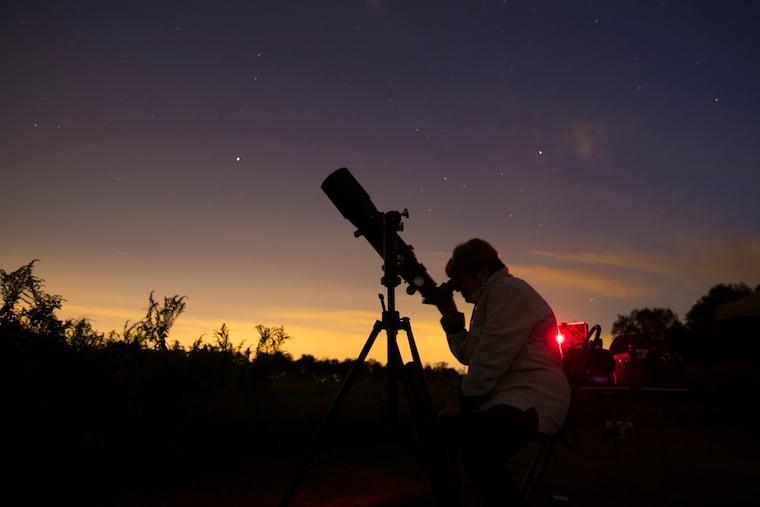The skies over Philly are about to get a new star as a result of a cosmic cataclysm
The “new” star will be about as bright as the North Star and will be visible for several days.

Any night now, the astrophysicists tell us, a new star will appear in the night sky over Philly and the rest of the world — about as bright as the North Star — the result of a cosmic explosion in a distant constellation millennia ago.
NASA scientist Rebekah Hounsell has called it ”a once-in-a-lifetime event that will create a lot of new astronomers out there.”
Once you see it, however, don’t get too attached to it. The so-called recurring nova star, T Coronae Borealis, which periodically mutates into an earth-size hydrogen bomb, will flame out in less than a week. But if you’re around, you’ll get another shot at seeing it at the beginning of the 22nd century.
Precisely when the nova, affectionately known as T CrB in the astronomical community, will be visible is unclear, astronomers say, and nailing the timing is a bit more complicated than predicting what time the sun will rise.
It could be sometime this month, maybe even this week, or maybe not until winter. But the evidence is unmistakable that it will appear soon.
» READ MORE: Here is a beginner's guide to the night sky over Philly
When will the star explosion happen?
It already has, about 3,000 years ago, around the time of King David (he who felled Goliath in one of the great upsets in human history); Zoroaster; the Iron Age; and the golden age of the Villanovan people, who overran northern Italy.
While that may seem a long time ago, in terms of cosmic time, this qualifies as breaking news, said Edward Sion, astrophysicist at Villanova University, which has no connection with the Villanovans, nor the nova in question. He believes its appearance may be imminent.
Astronomers know the explosion has occurred because it happens about once every 80 years, and looking into their backward crystal balls, they have observed that T CrB has undergone a signature loss in star power that has preceded previous cataclysms.
The nova — not to be confused with a self-destructing supernova — was last observed in February 1946, and before that, in May 1866. A German priest, Abbott Burchard of Upsberg, sighted it all the way back in 1217, according to astrophysicist Bradley Schaefer, an emeritus professor at Louisiana State University. The priest described it as “a faint star that for a time shone with great light.”
Sion said that mentions of the nova appear in the Middle Ages writings of Chinese and Korean observers. Of course, they didn’t have to contend with light pollution, but they also didn’t have the unprecedented observing power that astronomers have these days.
» READ MORE: Some towns in central Pennsylvania are waging war on light pollution
The new star poses no threat to us. It is 3,000 light years from Earth, which explains the lag: Light travels about 5.9 trillion miles annually. Do feel free to multiply 3,000 by 5.9 trillion. By comparison, the light from our star, the sun, beamed from a mere 93 million miles away, gets here in eight minutes and 35 seconds.
Why does the nova keep exploding?
The star’s nearest neighbor is a gigantic, gaseous nuisance. The nova is a “white dwarf,” the lesser half of a binary system in which two stars are bound together by gravity. Its partner is a “red giant” that leaks hydrogen because its gravity can’t hold it all, and eventually is lured by the gravitational system of its partner, the white dwarf nova, from the Latin for “new,” as in new star.
“It’s almost like a perfect storm,” said Villanova’s Sion. The white dwarf is an Earth-sized core of a dead star that is unimaginably hot, perhaps exceeding 180,000 degrees Fahrenheit, by NASA’s estimate.
When enough hydrogen accumulates on the white dwarf, the result is a nuclear explosion that NASA says is 10 times stronger than the annual output of the sun.
Said Sion, “Every 80 years, the white dwarf says ‘enough accreted mass already!’ I’m going to blow up!”
The result is that T CrB becomes visible to earthlings.
Where in the sky can you find the “new” star?
To find the nova, follow the tail that trails the “scooper” of the Big Dipper. That will lead you to Arcturus, one of the brightest stars in the sky. Just to the east of Arcturus is the Corona Borealis constellation, of which T CrB is an occasional member. The nova will be just below the apex of the constellation’s curved crown of stars, visible to the naked eye, said Sion.
When will the nova call it a career?
It isn’t clear when T CrB will stop being a recurring nova, but it’s possible that its career will come to a spectacular end, said Sion.
Someday it may undergo an ultimate detonation as a “Type 1a supernova,” which would be about 100,000 times as bright as our sun.
Even 3,000 light-years away, he said, that would be something to see.